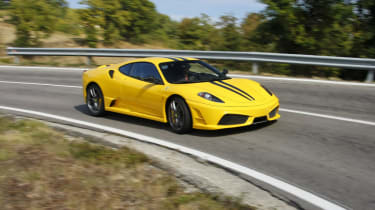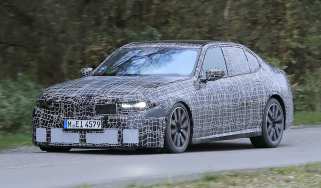Porsche 997 GT2 v Ferrari 430 Scuderia - Ferrari 430 Scuderia: Ferrari 430 Scuderia
Formula 1 for the road
When Ferrari drops ‘F1’ and ‘road’ into the same sentence, it’s talking about something entirely different based on four cast-iron, customer-savvy assumptions. One, you don’t want to grow lateral neck muscles resembling lengths of salami. So true. Two, Michael Schumacher can appear in as many dumb Fiat van TV ads as he wants so long as he works his personal brand of F1 development and set-up mojo on new Ferrari road cars. Three, none of this has anything to do with chasing F1 acceleration, cornering and braking and everything to do with repackaging the F1 work ethic for real-world consumption: capturing the rapid-fire rhythms, the scintillating aural and tactile cues, the constant interplay between precision and balance, the efficient exchange of effort for speed. And four, now that former race boss Jean Todt is CEO of the whole shooting match, the transfer of ideas, technology and engineering from F1 to the road car programme in pursuit of the above – always present as a strong undercurrent at Maranello – has gained a new, arguably defining, impetus.
Hence, I suspect, this schoolboy edition of what might otherwise be a routine (though hardly tedious) early-morning pre-drive briefing for the hugely anticipated 430 Scuderia unveiled at Frankfurt in September. Formula 1 for the road? We’re about to witness fusion at the nuclear level from a seat in what has to be the world’s greatest classroom, ‘the garage’ halfway down the main straight at Fiorano, Ferrari’s iconic shakedown circuit little more than a stone’s throw from the factory in Maranello.
More reviews
‘Garage’, of course, is something of an understatement. Yes, the cars drive in from the circuit, stop for adjustments, and drive back out. There are even a few shiny spanners lying around. But, on the whole, read hi-tech nerve centre with telemetry and data-logging capacity that must be roughly on a par with NASA’s Shuttle control. As we enter we’re handed red headphone comms sets just like technical director Ross Brawn used to wear on a Sunday afternoon before he decided to take a year off. This is pure theatre – everyone talking to us from the technical team speaks English – but perfectly on-message. ‘Scuderia’ is Italian for ‘team’, after all.
What happens next is brilliant. Instead of the usual slide-show and video, Ferrari F1 test driver Marc Gene climbs into the fully wired, 503bhp 430 Scuderia parked in the garage and goes for a blast round the track, his rapid but unerringly tidy progress tracked by a couple of strategically positioned video cameras and, telemetrically, on a huge LCD screen: acceleration, cornering, braking, steering inputs, gearshifts (now down to a blistering 60 milliseconds, or about the same as Schuey’s F1 car three years ago, which is as fast as the computer can safely disengage and re-engage the clutch), throttle and brake action, engine parameters and, most fascinatingly of all, the intervention of the traction and stability electronics.
The 430’s massaged power and torque outputs – plus 20bhp and 4lb ft (though spread over a much more robust-looking torque curve) – are perhaps as predictable as the 100kg sliced from the weight. A similarly classical approach turned the 360 into the demonically exciting Challenge Stradale, and the fundamental savings play a big part in shaving the 0-62mph time down to just 3.6sec.
But power-to-weight is just the starting point for the Scuderia. By combining the E-diff from the F430 with the 599 GTB’s F1-Trac traction control system, Ferrari has created possibly the ultimate high-performance driving aid. Gene has selected the ‘Race’ position on the newly re-configured manettino, the small dial on the steering wheel that determines the various parameters for the engine, gearshift, E-diff and traction and stability controls. ‘Race’ now allows the diff and traction control to work in concert, feeding in precisely the right amount of torque for the swiftest exit from any bend, even with the throttle nailed to the carpet (if there were any). It trims entry lines under braking, too.
Two of the four manettino settings let you progressively switch out first the traction and then the traction and stability electronics, so if you feel the need to go sideways there’s nothing stopping you but the Armco. (We’ll see later.) But for the best time, Gene wouldn’t, and neither would Schuey.
When Gene returns to the garage he tells of his surprise the first time he drove the 430 Scuderia, how he naturally found himself treating it the same way as the F1 car, without having to make the usual mental step-change. After a lengthy and eloquent dissertation on the finer points of the Scuderia’s performance round the company track, he concludes that, on any given corner, the difference in time from braking point to exit between himself and any one of us would be significantly flattened in this car. I’m not sure I believe him, but I guess we’ll find out on the track during the afternoon.
Meanwhile, there’s time to get acquainted with the Scuderia on the road. But not before photographer Shepherd and I simply stop and stare. I defy anyone who clocks this car for the first time not to. Despite the familiar shape and relatively compact dimensions, the Scuderia has colossal presence, especially in yellow. It isn’t just the full-length body stripes running from bonnet to rump, or the slightly wider front tyres (up from 225s to 235/35 R19s) or the lowered ride height; the car looks a whole lot less dainty than the regular F430 – stockier, shockier, thicker-necked. Plain tougher.
Then there’s the sight of those enormous carbon-ceramic brakes that would inhabit almost all the visible rim space behind the wheel spokes but for the partially eclipsing effect of the callipers (six-pot front, four-pot rear). And the closer you look the better it gets. The 19in rims wear bespoke super-sticky Pirelli P Zero Corsa rubber – just the tyres to exploit all that dynamic potential.
Despite the all-embracing weight-paring measures, the Scuderia’s cabin isn’t anything like as raw and crude as the 360 CS’s. Yes, there’s bare metal and a few exposed welds, but the combination of Alcantara, carbonfibre and ‘technical’ fabric strikes the right balance between habitability and hardcore. Likewise the fixed-backrest carbonfibre bucket seats that clamp you in place without cutting off the blood supply to any vital organs or limb extremities. Few steering wheels feel as good as the Scuderia’s, fewer wear such evocative switchgear – big red starter button, five-position manettino – and fewer still have quite such a pulse-quickening instrument display as a backdrop: if that bright yellow rev counter centre stage, calibrated to 10,000rpm, red-lined at eight and a half, doesn’t stir up a sense of anticipation, it’s hard to know what would.
We start slowly in the Maranello traffic, but let’s dispense with this part quickly. The Scuderia does everyday slob-around in its sleep. On light throttle openings and with the paddle-activated ‘F1-Superfast 2’ transmission on its default auto setting, it trickles and burbles innocuously, slurring sweetly between ratios. It’s hard to care much about the quality of the road surface, either. Credited to Schuey (though urged by just about all of us) was the decision to separate the adjustable damper settings from the manettino regime, so if I wanted to select ‘Race’ and embark on a Rendezvous-style death-wish dash across town, I could thumb a button on the centre console and still retain the supplest damper setting. Neat.
That said, as we head up into the hills, the extra flexibility this offers is little short of a revelation. Given that the road surface up here is more frequently scarred than smooth, I settle for maximum-attack gearshifts, traction control off (with stability still engaged) and soft dampers. It’s the best compromise, but even with the dampers on their firm setting, the ride is beautifully controlled and never jars. Nothing too challenging in the way of twisted tarmac yet, but the Scuderia already feels very different to the F430, not least in the way, in a heartbeat, it can flip between mild-mannered docility and feral ferocity.
It all pivots around 3500rpm, the engine speed at which the exhaust valves open (you’re going to notice this, everyone within a radius of three miles is going to notice it; think F430 re-mixed through Motorhead’s PA system) and the transmission shift program switches from easy-does-it to let-’em-have-it. When this happens, you instinctively grip the wheel a little tighter because, for a few moments at least, it seems impossible to pull back. You want to hear more of that astonishing engine note, and your brain scrabbles to sync with the sudden shift to an F1 metabolism. The intoxication is almost nerve-gas scary.
But, fact is, I want more of it. So rather than going in search of prettier, twistier roads, we head back to Fiorano. I grab a few frankly gobsmacking laps with chief test driver Dario Benuzzi (despite what some say, Dario’s still the man and has nailed a 1:25 in the Scuderia to prove it, matching the time for the Enzo), then, muttering ‘not bad’ with all the irony I can muster, I fire-up and head for the heart of Turn 1 myself.
It’s phenomenal: 503bhp and 347lb ft spat at the tarmac in rapid-fire chunks of scalp-prickling fury just 60 milliseconds apart. The exhaust note at flat chat is loud and penetrating enough to blow lumps off nearby buildings and curdle the milk in Fiorano’s kitchen. This isn’t an engine, it’s a noise weapon: extraordinary, unforgettable, dangerous.
The steering is exceptionally direct and precise. There’s a little deadness at low speed, but once it sheds that it becomes decently meaty and scalpel sharp. Although the Scuderia’s handling is at least partly prescribed by chassis electronics, the dynamic proposition it presents is pure and honest, stripped of frills and peripheral distractions. In ‘Race’ there’s a broad and adjustable band of behaviour that encourages commitment but doesn’t punish. In fact, you can ‘over drive’ it in the most outrageous manner and it will look after you – even make you feel like a hero. That was always one of Ferrari’s intentions. But, at the same time, the quality of the interaction between machine, butt and cerebrum is fabulous. You, the Ferrari and the road.
From this brief first encounter, Ferrari seems to have produced a car that combines the intimate purity of the 911 GT3 with the hardcore drama of a Lamborghini Superleggera while out-sprinting the 911 GT2 into the bargain. Hard to imagine this isn’t as good as it gets.
And for £172,500 – the price of a 599 – perhaps it should be. Then again, what price a car with an aura that makes your skin prickle as you walk up to it? The Scuderia is so much more than a stripped-out F430 with a loud exhaust and stickier tyres. The thrill of driving now has a name.
Specifications
| Engine | V8 |
| Location | Mid, longitudinal |
| Displacement | 4308cc |
| Bore x stroke | 92 x 81mm |
| Cylinder block | Aluminium alloy, dry sumped |
| Cylinder head | Aluminium alloy, dohc per bank, 4v per cyl, variable valve timing |
| Fuel and ignition | Electronic engine management, sequential multipoint injection |
| Max power | 503bhp @ 8500rpm |
| Max torque | 347lb ft @ 5250rpm |
| Transmission | Six-speed ‘F1-SuperFast 2’ |
| Front suspension | paddle-shift manual, rear-wheel drive, E-diff, F1-Trac |
| Rear suspension | Double wishbones, coil springs, adaptive dampers, anti-roll bar |
| Brakes | Double wishbones, coil springs, adaptive dampers, anti-roll bar |
| Wheels | Cross-drilled and vented carbon ceramic discs, 398mm front, 350mm rear, ABS, EBD |
| Tyres | 19in front and rear, aluminium alloy |
| Weight (kerb) | 235/35 ZR19 front, 285/35 ZR19 rear, Pirelli P Zero Corsa |
| Power-to-weight | 1350kg |
| 0-62mph | 378bhp/ton |
| Max speed | 3.6sec (claimed) |
| Basic price | 198mph (claimed) |
| On sale | £172,500 |
| evo rating | 5/5 |


